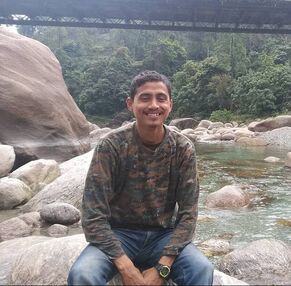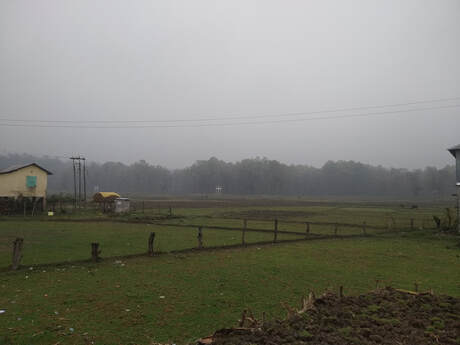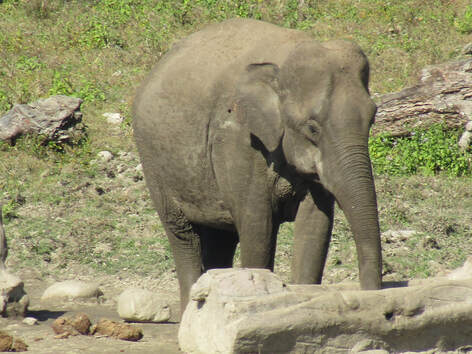|
Mr. Amir Kumar Chhetri, a community conservationist from West Bengal’s Panijhora Village was interviewed by YNN members Rohith Srinivasan and Aditya Ramakrishnan as part of our World Ranger Day initiative, “In Nature’s Defence”.
In addition to being a tourist guide for safari rides in the adjacent Chapramari Wildlife Sanctuary, Mr. Chhetri is a Project Associate at the Coexistence Project and a Project Leader with Sanctuary Asia’s Mud on Boots Project. Having lived in close proximity to forests from his childhood, Mr. Chhetri understands the importance of nature and involving local communities in conservation efforts.
|
When I was a kid, I didn’t know much about wildlife despite living right beside the forest and only knew of those creatures that visited our fields. When I was in class 7 or 8, I started working as a tourist guide on the gypsy safaris that used to happen. This triggered an interest in wildlife in me, which grew over time. About 7 or 8 years ago, I got the opportunity to work as a field assistant to a researcher in Chapramari Wildlife Sanctuary and then joined the Coexistence Project as a project associate in 2017.
My initial work with the Coexistence Project was related to performing various scientific surveys. These were mainly related to elephants and leopards. I have been involved in assessing the occupancy of leopards and elephants, camera trapping leopards in tea estates, studying the foraging behaviour of elephants and interviewing villagers about the patterns of man-animal conflict, among other things. I was also greatly involved in spreading awareness among the locals about how to handle elephant and leopard encounters and the do’s and don’ts of peaceful coexistence. It’s important to involve local communities in conservation because it is the best way for them to learn about wildlife and everything around them. Only by knowing all of this will they be able to protect themselves as well as the ecosystem around them.
My village, Panijhora, falls within the limits of Chapramari Wildlife Sanctuary. We try our best to live in harmony with nature- we have a very active Joint Forest Management Committee and an Eco-Development Committee. The villagers choose a secretary for the latter, who decides the roles everybody plays. We have forest rights and go to collect firewood and cattle fodder from the forest. If the Forest Department needs any help, with plantation work or with a sudden fire, we volunteer to help them. A lot of people from our village are dependent on the Panijhora tourist lodge run by the Forest Department- they perform in cultural events, cook and do other miscellaneous jobs. The jute handicrafts sold to tourists through the Forest Department are another source of income for my fellow villagers. Our village practices sustenance farming of paddy, maize and mustard. We don’t sell any of our crops and grow only enough for our consumption.
I love everything about my job and have nothing to complain about. The favourite part of my job was when we had radio-collared some elephants. We tracked two herds, the names of whose matriarchs were Meenakshi and Santa. We’d collared them around 2019 so their collars have fallen off by now. As a child, I’d heard that elephants travel long distances but I realised that this was a reality only while tracking the radio-collared herds. I understood their way of life then- where they rested, how they ate and how they behaved. I really enjoyed observing them at such close quarters.
One of my favourite memories was from when I was tracking a herd. I started following them from a tea estate called Aibheel and was only about 500m away from them. I kept walking behind them until we reached another tea estate, Kilkote, which was almost 4km away. Since they had calves with them and the sun had started to rise, I thought the herd would stop to rest at Kilkote but instead they crossed a river next to the estate into a patch of forest. I followed them into the forest as well. Throughout my walk, the herd had been keeping an eye on me but not once did they try to shoo me away or show any signs of aggression. That day, I realised that the elephants understood what I was doing and that they would never attack me or anybody else unless they felt threatened. In fact, elephants are my favourite species, partly because I’ve seen them since my childhood. They are incredibly sensible, I’d say even more sensible than most people and I really respect them for it. In our village, we have watchtowers around our fields. I’ve noticed that elephants have never broken into our village and attacked anyone, no matter how close they may come. If people are around, they try to find other routes to reach their destination.
One of my favourite memories was from when I was tracking a herd. I started following them from a tea estate called Aibheel and was only about 500m away from them. I kept walking behind them until we reached another tea estate, Kilkote, which was almost 4km away. Since they had calves with them and the sun had started to rise, I thought the herd would stop to rest at Kilkote but instead they crossed a river next to the estate into a patch of forest. I followed them into the forest as well. Throughout my walk, the herd had been keeping an eye on me but not once did they try to shoo me away or show any signs of aggression. That day, I realised that the elephants understood what I was doing and that they would never attack me or anybody else unless they felt threatened. In fact, elephants are my favourite species, partly because I’ve seen them since my childhood. They are incredibly sensible, I’d say even more sensible than most people and I really respect them for it. In our village, we have watchtowers around our fields. I’ve noticed that elephants have never broken into our village and attacked anyone, no matter how close they may come. If people are around, they try to find other routes to reach their destination.
Unfortunately, there is a lot of man-animal conflict in the region, particularly with elephants and leopards. So through the Coexistence Project, I work on awareness projects and explain to people that the tea estates here are the homes of leopards, that they only attack if they are threatened and how to avoid them. I also ask everybody I meet not to disturb the animals and not to try and relocate them as they eventually return to their original homes anyway- they have a strong homing instinct. A recent study found that one of the leading reasons for humans being killed by animals was because of a lack of adequate lighting when they go out at night. So we’ve tied up with an NGO to distribute torchlights among the people here- this way they’d be able to tell if an animal like an elephant was in the vicinity and move away in time. We’re also working on setting up a solar fence around our village’s fields, which are adjacent to the forest. It will be maintained by the whole community and people will take turns to cut any grass that may grow below the wires, ensure that no one steals any parts and get it repaired whenever needed. There are also many organisations that we’ve worked with before who we can approach if we need any technical assistance.
COVID-19 certainly had an impact on my job. Unlike the second wave, we were completely unaffected by the first wave and there were no cases here but tourism in the forest was stopped completely. I also work as a tour guide for safaris and used to earn about Rs. 300 for every safari I guided. So in a week, if I went on 3 safaris, I was assured around Rs. 900. But because of the pandemic, this source of income was cut off for me, thus affecting me financially.
Our region gets about 3000mm of rainfall every year. But most of the time, it isn’t really a problem. The rains will come and we have to live with them. Waterlogging isn’t an issue because the soil here is such that water doesn’t stand for too long. However, illegal sand mining and boulder collecting in the beds of rain-fed rivers has become rampant here. Even a few workers from the tea estates collect stone chips and sand because it’s an easy source of income for them and their livelihoods aren’t sufficient to sustain them and their families. Now, during the monsoon, the river breaches into the forest, reducing its size. The number of trees has also reduced because of human activities. Due to all this, I feel that people from this region are falling sick more often. Based on this, I have a final message for people reading this- we only exist because of nature and we need to protect it. If we don’t cooperate to protect wildlife and nature at large, we will eventually end up being affected very badly.
All photographs used in this article belong to Ms. Priyanka Das.
We are extremely grateful to Ms. Priyanka Das, who stayed on call during the interview and translated Mr. Chhetri’s words from Bangla to English. Priyanka has completed her M.Sc in Ornithology and Conservation Biology from SACON, Coimbatore and is currently working as a project coordinator at the Coexistence Project. She too had a final message saying that one need not be a professional in the field to have an impact. She said that one’s individual discipline and choices are what is most important and that small things like girls choosing to use menstrual cups instead of sanitary napkins could make a difference.
We would also like to thank Sanctuary Asia's Mud on Boots Project for their assistance in contacting Mr. Amir Chhetri for this initiative.




